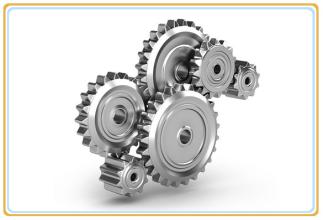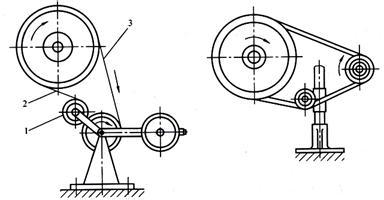机械工程英文论文代写|机械本科硕士英文Essay代写
发表时间:2016-10-12 14:12:02 作者:admin 阅读:101次

机械工程技术属于理工科范畴,近几年的留学生群体中,机械工程专业的留学生逐年增多。外国的移民政策也越来越青睐机械类的技术工程师,所以如果选择留学读机械类专业还是不错的。本文是一篇关于机械工程学-散热器与微处理器在机械工程学的中的应用研究,散热器改良的研究,Engineering Engineering Essay代写在用的很多,本文是一篇英国机械工程专业英文论文代写范文,以下是全文的一些介绍:
The increase in dissipated power per unit area of electronic components sets higher demands on the performance of the heat sink. Also if we continue at our current rate of miniaturization, laptops and other electronic devices can get heated up tremendously. Hence we require a better heat dissipating system to overcome the excess heat generating problem which is expected to power the next generation of computers. To handle the excessive and often unpredictable heating up of high performance electronic components like microprocessors, we need to predict the temperature profile of the heat sink used. This also helps us to select the best heat sink for the operating power range of any microprocessor. Understanding the temperature profile of a heat sink and a microprocessor helps us to handle its temperature efficiently for a range of loads.
The digital integrated circuit (IC) called a microprocessor. A microprocessor incorporates the functions of a computer's central processing unit (CPU) on a single integrated circuit (IC), or at most a few integrated circuits. It is a multipurpose, programmable device that accepts digital data as input, processes it according to instructions stored in its memory, and provides results as output. It is an example of sequential digital logic, as it has internal memory. Microprocessors operate on numbers and symbols represented in the binary numeral system. The advent of low-cost computers on integrated circuits has transformed modern society. General-purpose microprocessors in personal computers are used for computation, text editing, multimedia display, and communication over the Internet. Many more microprocessors are part of embedded systems, providing digital control of a myriad of objects from appliances to automobiles to cellular phones and industrial process control.
As we know that Today's rapid IT development like internet PC is capable of processing more data at a tremendous speed. This leads to higher heat density and increased heat dissipation, making CPU temperature rise and causing the shortened life, malfunction and failure of CPU. Electronic portable devices, especially desktop PC, CPU have become challenging and popular nowadays. The new wave of computer technology making a crucial impact on modern world and desktop computer is widely employed in state-of-the-art industry. The failure rate of electronic components grows as an exponential function with their rising temperature. Power dissipation would be a major bottleneck to development of the micro electronics industry in the next 5 to 10 years. The performance level of electronic systems such as computers are increasing rapidly, while keeping the temperatures of heat sources under control has been a challenge.
Microprocessor chip
Many cooling techniques such as cooling by the heat pipes, cold water, and semiconductor and even by liquid nitrogen were proposed and adopted. Liquid nitrogen cooling is very expensive and not suitable for conventional use. Due to cost constraints, conventional air cooling technology with a fan, heat sink combination widely used to cool desktop computers. The air cooling technique is always significant and worthy of further study. The challenging aspect for improving heat sink performance is the effective utilization of relatively large air cooled fin surface areas when heat is being transferred from a relatively small heat source (CPU) with high heat flux.
We need to go far back in time to remember a CPU that was able to operate completely without a heat sink. The first Intel processors were already producing considerable amount of heat, but the low specifications allowed operation without any heat removal mechanism. A little later, as the processing speed increased, these processors required at least a passive heat sink for trouble free operation. However, for the last few years, as the processors got more and more powerful, it has become mandatory that a CPU requires a multifin heat sink as well as a fan that ensures reasonable air flow through the cooling fins as the overheated processors exhibit a shorter maximum life span and often results in problems like system freezes or crashes.
Heat is generated by all semiconductors while operating. Most microprocessors to date have been able to dissipate the heat directly to the ambient air without heat sinks or fans. With faster processors that dissipate more heat than the slower processors, it is no longer possible to ignore thermal management. The objective is to ensure the generated heat is dissipated into the ambient air while a safe operating temperature is maintained. There are several methods for keeping the processor cool. All of these methods include a combination of heat sink and airflow. In general, the trade-off is heat sink versus airflow. A smaller and less costly heat sink requires more airflow. Analogously, larger heat sinks require less airflow to maintain a safe case temperature.
Heat sink:
A heat sink is a device used in computers to remove the large amount of heat generated by components, including ICs such as CPUs, chipsets and graphic cards, during their operation. A heat sink is used to increase the surface area which dissipates the heat faster n keeps the ICs under safe operating temperature. Fans are also used to speed up this process. It usually consists of a base with one or more flat surfaces and an array of fin like protrusions to increase the heat sink's surface area contacting the air and thus increasing the heat dissipating rate. A combination of a heat sink and a fan is widely used which maintains a larger temperature gradient by replacing warmed air more quickly. Heat sinks are made from good thermal conductors such as copper or aluminium alloy. Copper is significantly heavier and more expensive than aluminium but it is also roughly twice as efficient. The most common of a heat sink is a metal device (Cu or Al) with many fins.
Fig2 Heat sink with fan
To remove the heat from microprocessor we generally use air cooled heat sinks with fans.
Types of heat sink:
The most common types of air-cooled head sinks includes,
Stamping: Copper or aluminum sheet metals are stamped into desired shapes. They are the widely used type in air cooling of electronic components and offer a low cost solution to low density thermal problems.
Extrusions: This method allows the formation of elaborate heat sink structures which are capable of dissipating more heat. As more number of fins can be made in this type, it increases the performance from 10 to 20%.
Fabricated/Bonded Fins: The overall performance of an air-cooled heat sink can be improved significantly by increasing its surface area. This method allows us to bond fins to the aluminium base, hence increasing the surface area.
Castings: This technology is used in high density pin fin heat sinks which provide maximum performance while using forced air system.
Folded Fins: Corrugated sheet metal - either aluminum or copper, increases surface area, hence the performance. It is not suitable for high profile heat sinks, but it allows high performance heat sinks to be fabricated for specific applications.
The different papers are review for this topic & the literature review regarding this topic is explained as follows
Avram Bar-Cohen & Peng Wang concludes that the temp of microprocessor is not same at every cross section it varies point to point. He also concludes that the temp range of hot spot is 5 to 30°c & the temp increases with respect to hot spot size. The temp of microprocessor is maintained by using thermo electric coolers (TEC'S) & different thermal interface materials (TIM'S)

The rapid emergence of nanoelectronics, with the consequent rise in transistor density and switching speed, has led to a steep increase in microprocessor chip heat flux and growing concern over the emergence of on-chip hot spots. Attention is devoted to thermoelectric micro coolers and two-phase micro gap coolers. The advantages and disadvantages of these on chip cooling solutions for high heat flux hot spots are evaluated and compared.
R. Mohan and Dr.P. Govindarajan identify a cooling solution for a desktop computer, which uses an 80 W CPU maximum whereas this number will be increased in the range of 70-120W in the forthcoming desktop computer systems. The design is able to cool the chassis with one fan with air blowing over heat sink attached to the CPU is adequate to cool the whole system and the power supply fan. They consider the optimal plate fin heat sink design and cylindrical fin heat sink design with variable copper base plate and the control of CPU heat sink processes. To have a better heat dispersion performance of microprocessor & CPU. They model the rectangular and cylindrical fins of thickness from 0.5mm to 2.5mm with and without base plat also he varies the base plate thickness from 0.5mm to 2.5mm and compare the results by considering the base plate thickness, thickness of fins, no. of fins and fin geometry at every condition and finally conclude that stacking too many fins is not a solution for decreasing the hot spots on the heat sink since they may prevent the passage of air coming from the fan to the hottest centre parts of the heat sink. It was shown that the improvements on heat sink designs are possible with the help of CFD.
------- For idle load
____ for full load
If base plate material is selected to be copper rather than aluminum, then the thermal resistance of the heat sink decreases as expected. However, this makes the heat sink more expensive and heavier. The heat sink fin thickness is also a parameter for improvement. When the base plate thickness was increased, the heat sink performed better. However, there are space limitations for every heat sink in a computer. Therefore, the total height of the heat sink should be considered together with the space limitations when increasing the height of the base plate. Finally they conclude that although the heat sink dimensions are same, C-C heat sink gives higher heat transfer rates. Without copper base plate 1.5 mm thickness C-C heat sink performance is tremendously well when compare to 1.5mm thickness Al heat sink model with copper base plate. The performance of plate fin heat sink model is better when compared to all cylindrical fin heat sink models. The 3.5 mm thick cylindrical fin model with 5 mm copper base plate only performs well than other models. It is observed that 1.5mm thickness heat sink model performs well than other two thickness heat sink model. Even though it has less the number of fins it performs well. It is noticed that instead of increasing number of fins by increasing the thickness of fins the performance of heat sink is increased. Even if the heat sink dimensions are same for all three cases, the heat sinks with base plate enhance the heat transfer rate. Copper base plate heat sink performs well when compared to aluminum base plate heat sink. By increasing the base plate thickness and changing the material of base plate the performance of heat sink is enhanced. It is also observed that by adding the base plate increases the heat conduction rate instead of increasing the fin height.
Saket Karajgikar & Dereje Agonafer concludes that functional units of the Pentium IV micro architecture were repositioned to minimize the junction temperature without, or with only minimal, effect on microprocessor performance. The die was divided into 36 equal blocks, which were then grouped based on their functionality to numerically represent the actual 24 functional units. Based on the functionality of each unit, they were categorized in four groups: front end (FE), execution cores (EX), bus and L2 (BL2), and out-of-order engine (OE). Numerical analysis was performed using a commercially available CFD code to optimize the location of functional units for improved thermal management. The results of more than 10,000 scenarios depicted a ΔT of 5.7°C between the minimum and maximum temperatures. Performance penalties ranged from minimal less than 2% to 30%. Also, the thermal performance of any micro-architecture depends on the heat flux rather than the power dissipated by individual functional units. From the results, the minimum and the maximum temperatures were 56.6°C and 62.2°C. The temperature difference will vary depending on the type of architecture, clock speed, bus speed, and cache size. Based on the analysis, the optimized scenario resulted in a junction temperature of 56.6°C with a performance loss of 14%.
B.Sri Aravindh & Dr.T.R.Gopalakrishnan Nair analysis the performance of heat sink by using numerical techniques and conclude that the heat sink is designed in such a way that its thermal resistance is kept to the minimum possible value. The entire design process looks at the thermal resistance as the primary item to be calculated. The actual temperature of the microprocessor can be predicted with the calculated value of thermal resistance. Power components have a maximum junction temperature, which must not be exceeded to prevent damage to the device. Devices are encapsulated in packages which have different levels of thermal resistance. When designing power electronics, the heat dissipation of the device, coupled with any heat sinks, as well as the maximum power dissipated by the device, must be analyzed to insure that the device operates within allowable specified limits.
From his work he conclude that as time increases the temp of the microprocessor increases at full & idle load conditions as shown in fig.
Heat sink temperature Profile
C. J. Shih and G. C. Liu optimize the fin design of heat sink for Electronic Cooling Using Entropy Generation Strategy. A formal systematic optimization process to plate-fins heat sink design for dissipating the maximum heat generation from electronic component by applying the entropy generation rate to obtain the highest heat transfer efficiency. The design investigations demonstrate the thermal performance with horizontal inlet cooling stream is slightly superior to that with vertical inlet cooling stream. However, the design of vertical inlet stream model can yields to a less structural mass (volume) required than that of horizontal inlet stream model under the same amount of heat dissipation. In general thermal design of a heat exchanger, one can either minimize total thermal resistance or maximize the total efficiency as the design goal. When one observes, the minimization of has the tendency to maximize the convective coefficient, the total fins surface area, and total thermal efficiency, simultaneously. However, each of the individual design parameters are not being maximized; rather; the product of their values is being minimized. In a general heat sink design problem, the heat dissipation and stream temperature can be required to prescribe in advance. Consequently, the minimization of entropy generation rate is equivalent to the minimization of total thermal resistance as well as minimizing simultaneously. Therefore, the design strategy of minimizing entropy generation rate has the effect of maximizing the thermal efficiency, surface area, and convective coefficients.
CONCLUSION
As a microprocessor is a very important part of CPU and it workes by using electrical energy and while performing operation this electrical energy is converted in to heat energy and the microprocessor get heated.for the trouble free operation of CPU the temperature of microprocessor must be keep in the safe limit temperature and to mentain this safe temperature the best design of heat sink is necessary. For this purpose we need to concentrate on the design of heat sink which is used to cool the microprocessor and to mentain the safe operating temperature of microprocessor.
From above reviews it is conclude that by varying the specific design parameters of heat sink we obtain the optimal solutions and future recommendations for heat sink designs.as we varry the parameters like,
Shape of fins.
Thickness of fins.
No. of fins.
Thickness of base plate.
Spacing between fins.
Geometry of fins.
We get improved result of heat dissipation by the heat sink.
机械工程领域论文专业性很强,需要掌握大量的专业知识以及较高的英语水平才能完成一篇优秀的Essay,美伦论文网拥有机械工程专业级写手,能帮您完成机械工程相关的英文论文代写服务。支持Turnitin检测,100%Pass保障,是您代写机械论文的最佳选择,如果您有相关需求,欢迎联系我们的在线客服。



